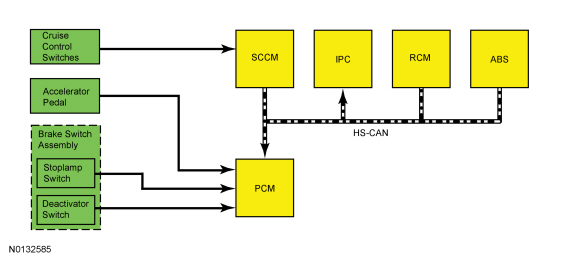SECTION 419-03A: Cruise Control — Non-Adaptive
| 2014 Flex Workshop Manual
|
DESCRIPTION AND OPERATION
| Procedure revision date: 05/02/2013
|
Overview
The cruise control system is controlled by the PCM. The cruise control mode is selected from the steering wheel mounted switches (ON/OFF, SET, CNCL and RES) which are integrated into the LH steering wheel switch. The cruise control system maintains a selected vehicle speed between 37 kmh (23 mph) and the maximum limited vehicle speed. When a MyKey® restricted key is in use and maximum speed limiter is turned on, vehicle speed is limited. The maximum vehicle speed can be set to 105 kmh (65 mph), 113 kmh (70 mph), 121 kmh (75 mph), or 129 kmh (80 mph). During normal driving, the vehicle speed can vary slightly from the set speed due to road conditions. The vehicle speed can fluctuate when driving up and down a steep hill. If the vehicle speed decreases more than 16.1 kmh (10 mph) below the set speed, the cruise control disengages.
System Operation

Network Message Chart
Module Network Input Messages — IPC
| Broadcast Message | Originating Module | Message Purpose |
|---|---|---|
| Cruise control override | PCM | Driver overriding cruise control with accelerator pedal. |
| Cruise control status | PCM | Data used for cruise control indicator status. |
Module Network Input Messages — PCM
| Broadcast Message | Originating Module | Message Purpose |
|---|---|---|
| Steering wheel switch speed control | SCCM | Used for cruise control enable/disable and operating mode request. |
| Speed control deactivation request | ABS module | Deactivates cruise control when requested. |
| Stability control event in progress | ||
| Traction control event in progress | ||
| Vehicle lateral acceleration | RCM | Deactivates cruise control when requested. |
| Vehicle longitudinal acceleration | ||
| Vehicle roll sense | ||
| Vehicle yaw rate |
Cruise Control Operation
The cruise control functions include:
Hardwired inputs to the PCM are:
Hardwired outputs from the PCM are:
The vehicle speed is controlled by the PCM through the ETC subsystem.
The cruise control system provides self-diagnostics. Cruise control is disabled anytime an error is detected in the system. No IPC indicator or message center messages are displayed when faults occur. Fault codes are logged by the PCM or SCCM .
An ETC system fault also causes the cruise control system to be disabled. In this case, an ETC system powertrain malfunction (wrench) warning indicator is displayed.
Additionally, certain conditions cause the cruise control system to deactivate:
Cruise Control Indicator
The cruise control indicator, located in the IPC , illuminates gray to indicate the cruise control system is in standby mode. The cruise control indicator illuminates green to indicate the cruise control system is active.
Steering Wheel Switch Function
Pressing up (ON) and releasing the ON/OFF switch turns the cruise control system on. Pressing up (SET+) or down (SET-) on the SET switch while the vehicle is traveling at the desired speed activates the cruise control system.
Pressing up or down on the SET switch while in the active mode increases or decreases the maintained vehicle speed by 2 kmh per press when displayed units are "kmp" and 1 mph per press when displayed units are "mph". If the respective switch is pressed and held, the vehicle speed continues to accelerate or decelerate until the switch is released.
Pressing down (OFF) and releasing the ON/OFF switch, or turning the ignition switch to the OFF position, turns the cruise control system off. While the cruise control system is active, applying the brake pedal or pressing the CNCL (CANCEL) switch puts the cruise control system into standby mode. Pressing the RES (RESUME) switch when the cruise control system is in standby mode causes the vehicle to accelerate to the last set speed. Resume does not function if the OFF switch is pressed, the ignition switch is cycled OFF, or if the current vehicle speed is below the minimum operational speed.
Cruise Control Deactivation Event Parameter Identification (PIDs)
NOTE: When recording deactivation event PIDs, turn the cruise control OFF immediately after the deactivation event occurs to prevent recording additional deactivation events which do not apply to the fault present.
The PCM has PIDs available through the powertrain DataLogger that indicate the event that caused the last cruise control deactivation. When the cruise control is turned ON, all current deactivation (or non-activation) conditions are recorded. When the cruise control is turned OFF, event recording stops. The recorded events are stored until the ignition is turned OFF.
The PCM has 24 cruise control deactivation event PIDs, identified as CRUISEOFF_00 through 24. The event PIDs should be read when deactivation or non-activation exists.
Component Description
Steering Wheel Switches
The cruise control steering wheel mounted switches are momentary contact switches that toggle up and down for the switch state. The switches are an input to the SCCM .
Brake Switch
When the brake pedal is applied, an electrical signal from the stoplamp circuit to the PCM deactivates the system. Under increased brake pedal effort, the cruise control deactivator switch opens and removes the ground signal from the PCM input circuit releasing the throttle, immediately deactivating the system.